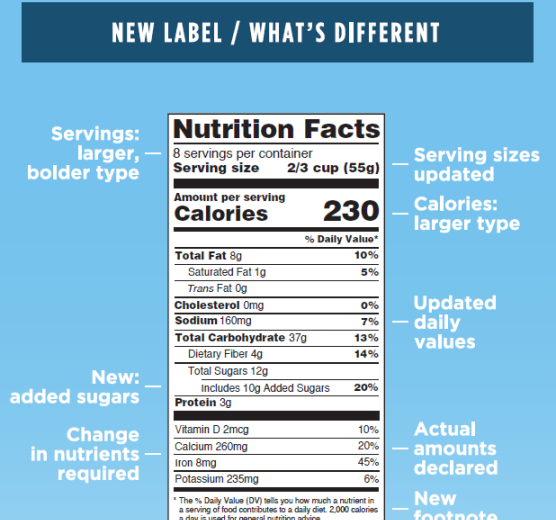Ever read that little “Nutrition Facts” panel on the packaged foods you choose? I tend to spend too much time in the grocery store scrutinizing those, to pick out the healthiest choices. Over the years, those labels have changed to reflect our changing understanding of what’s good (and bad) in nutrition: the clarification of serving sizes, the addition of saturated and trans fat information, and the simplification and improvement in readability.
The U.S. government will soon be updating Nutrition Facts requirements again. Among the changes:
- It will list how much added sugar is in a processed food. This is important, since added sugars are one of the leading detriments to Americans’ health. The recommended maximum is 50 grams daily; the average American eats over twice that amount (115 grams, or about 23 teaspoons).
- Serving sizes will be updated to more closely reflect the amount of a food people actually eat. Artificially small serving sizes distort the amount of calories, fat, and sodium listed.
- Calories will be larger and bolder.
- Daily values will be updated to reflect the most recent science. The daily value for fiber (one of my favorite nutrients) has been increased from 25 grams to 28 grams, for example.
- Potassium and vitamin D, two nutrients that Americans tend not to get enough of, will now be featured on food labels.
Some food industry leaders have fought these changes – food labeling has always been as much (or more) about marketing and politics than about science. So it’s good to see nutritional science taking the upper hand for once. This continues the positive trend we saw the last couple of years with the introduction of NuVal, a single number to express the overall nutritional quality of a food. Not surprisingly, that science-based, user-friendly system was the result of actual nutritional science experts, not a government committee.
Of course, the truly healthiest choices are whole foods – fresh lean meats and fish, fruits, vegetables, and whole grains. But when we do select packaged foods, we will soon have better information at our disposal.




It’s good to see the nutrition facts changing a few things around, especially the serving size. Sometimes it seems like something is better than it really is. You need to be very careful.